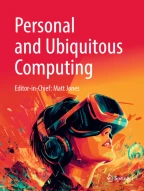Abstract
The projects presented in this paper address two issues. The first issue is about the act of interactivism of liberating the projector, and the subsequent design considerations of taking a certain technology out of its intended context, and the issue of breaking out of the ‘frame’. The second issue is about how video material through personal projection becomes a human output modality, potentially enabling a new and exciting form of audiovisual expression. This restores the balance of the enormous amount of images (still and moving) we take from out environment, but rarely give back. To address this asymmetry, the Videowalker project has been developed, as an instrument and an idea. It aims to address the urban space and the natural environment with audiovisual material, responding and reflecting on the context. Through the project the trend of portable projectors is anticipated, with the explicit aim to investigate how this technology can be used as an expressive human output modality. This means that a strong emphasis in the development and design processes is put on the interface as well as the audience experience. The paper describes the background of the project and its approaches, and experiences and reflections on a range of instantiations/performances with the instrument in Spain, The Netherlands and Australia since 2003. The technology of the set-up is described in enough detail to enable others to replicate the system. Related projects are described and compared, and the notion of Videowalk is placed in an artistic historic context. From the experiments and events a number of issues have come up, and identified as the most important design parameters to research were the shape of the projection and the nature of the audiovisual content.
Similar content being viewed by others
Notes
Max is a visual programming language, object based and low level. MSP is the sound manipulating part, and Jitter the real-time video manipulating part. See http://www.cycling74.com.
References
Bongers AJ, Van der Veer GC (2007) Towards a multimodal interaction space—categorisation and applications, special issue on movement-based interaction of the Journal of Personal and Ubiquitous Computing 11(8)
Bongers AJ, Harris YC (2002) A structured instrument design approach: the video-organ. In: Proceedings of the conference on new instruments for musical expression, Dublin, Ireland
Harris YC, Bongers AJ (2002) Approaches to creating interactivated spaces, from intimate to inhabited interfaces. Organ Sound J 7/3, special issue on interactivity. Cambridge University Press
Bongers AJ (2006) Interactivation—towards an e-cology of people, our technological environment, and the arts. PhD thesis, Vrije Universiteit Amsterdam
Bongers AJ (2009) Audience movements and spatial interaction—interactive video installations addressing architectural space. Proceedings of the SEAM conference, Sydney
Scheible J, Ojala T (2009) MobiSpray: mobile phone as virtual spray can for painting BIG anytime anywhere on anything, special issue of Leonardo. J Int Soc Arts Sci Technol 42(4):332–341
Schöning J, Rohs M, Kratz S, Löchtefeld M, Krüger A (2009) Map Torchlight: a mobile augmented reality camera projector unit. In: Proceedings of the 27th international conference extended abstracts on human factors in computing systems, ACM, pp 3841–3846
Verlinden JC, de Smit A, Peeters AWJ, van Gelderen MH (2003) Development of a flexible augmented prototyping system. J WSCG 11(3):496–503
Verlinden JC, Horvath I (2008) Enabling interactive augmented prototyping by a portable hardware and a plug-in-based software architecture. J Mech Eng 54(6):458–470
Raskar R, Beardsley P, Van Baar J, Wang Y, Dietz P, Lee J, Leigh D, Willwacher T (2004) RFIG lamps: interacting with a self-describing world via photosensing wireless tags and projectors. ACM Trans Graph 23(3):406–415
Blaskó G, Coriand F, Feiner S (2005) Exploring interaction with a simulated wrist-worn projection display. In: Proceedings of the ninth IEEE international symposium on wearable computers (ISWC ‘05). IEEE Computer Society, Washington, DC, USA, pp 2–9
Kastner J, Wallis B (eds) (1998) Land and environmental art. Phaidon, London
Forbat S (2009) 40 years: Kaldor public art projects. Art Gallery of NSW, Sydney
Dew C (2007) Uncommissioned art: an A–Z of Australian Graffiti. The Miegunyah Press, Melbourne
Peiter S (2009) Guerilla art. Laurence King Publishing, London
Raskar R, van Baar J, Beardsley P, Willwacher T, Rao S, Forlines C (2003) iLamps: geometrically aware and self-configuring projectors. In: Proceedings of the ACM SIGGRAPH
Banksy (2005) Wall and piece. Random House, USA
Acknowledgments
Many thanks to the curators and venues of the presentations: Sydney Pecha Kucha (Marcus Trimble and Sarah Hearne), the SEAM festival (organisers Margie Medlin of Critical Path and Samantha Spurr of UTS) and the In Temperance laneway project (curator Mark Titmarsh). Thanks to Stephanie and Thomas for demonstrating the laneway video audience instrument. Many thanks to Frank Maguire and Alejandra Mery-Keitel for taking some of the photographs of the SEAM performance and Martin Fox for video camera and editing (SEAM performance) and Jason McDermott (camera at Pecha Kucha and SEAM).
Author information
Authors and Affiliations
Corresponding author
Rights and permissions
About this article
Cite this article
Bongers, B. The projector as instrument. Pers Ubiquit Comput 16, 65–75 (2012). https://doi.org/10.1007/s00779-011-0378-0
Received:
Accepted:
Published:
Issue Date:
DOI: https://doi.org/10.1007/s00779-011-0378-0
